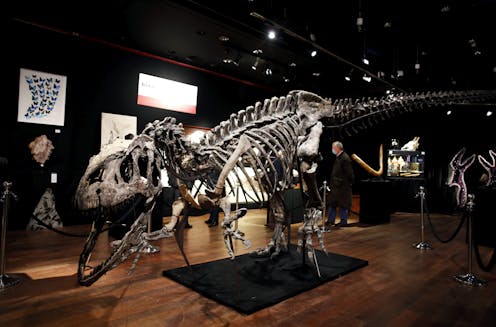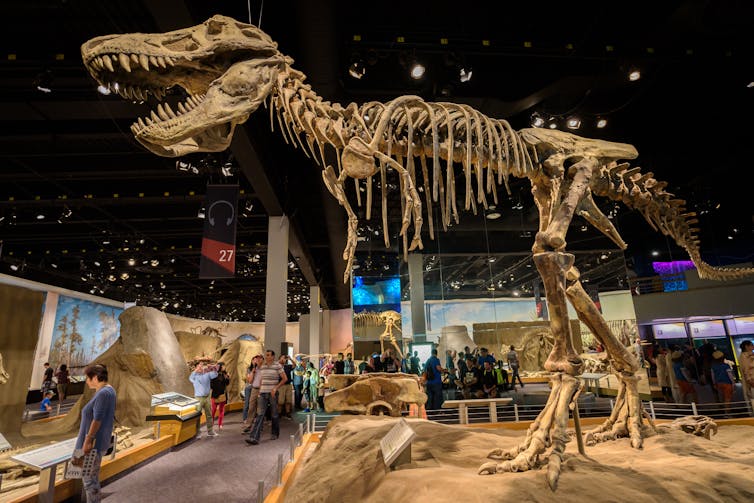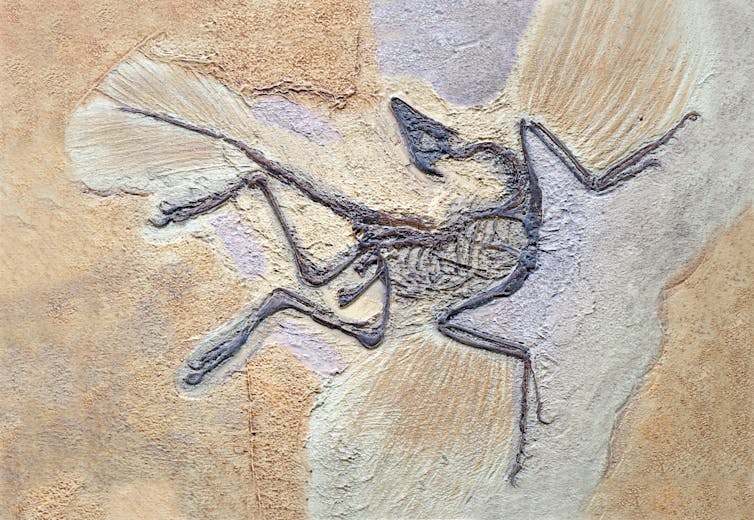
In mid-May, Christie’s auction house in New York sold a raptor skeleton (Deinonychus) for US$12.4 million. This represents a failure to protect and share our natural history with everyone.
We are paleontologists and represent the Society of Vertebrate Paleontology, a group of 2,000 scientists, students and museum professionals around the world. We are promoting awareness of the problems that high-profile auctions of vertebrate fossils cause, and why we think they shouldn’t happen.
Fossils are fascinating and beautiful objects. They provide a glimpse into a past substantially different from our present. We love seeing them come to life in movies. As paleontologists, we share the wonder, but when significant fossil specimens are held by individuals and not public institutions, society loses.

Private ownership, public losses
Loss of high-profile dinosaur skeletons clearly hurts both science and the public. Some countries have a sense of “cultural patrimony” that includes not only cultural heritage, but natural heritage as well. This informs their laws, and prevents fossil sales and the unauthorized removal of fossils from their countries. When a fossil is sold, this heritage is removed from people in that country without consent.
When people are permitted access to private fossil collections, they are often from the purchaser’s country and not from the specimen’s country of origin, leaving local people cut off from seeing the fossil and learning about their own natural heritage. Not surprisingly, laws protecting cultural and natural heritage are often strongest in countries who have suffered the greatest loss of this heritage, like Mexico.
How much have the United States and other countries without legal protections in place lost through fossil auctions? We are only just beginning to understand. Of the known specimens of Tyrannosaurus rex, only 55 per cent are in collections in the public trust — and the remainder are in private hands.
The scientific community also loses. Specimens complete enough to be sold at legal auctions are often of significant scientific value, but may have been prepared in ways that inflate esthetic value at the expense of long-term stability.
Benevolent purchasers might want scientists to study their specimens, but there is no guarantee that primary data is recorded, rendering the fossil less meaningful for scientific research. Casts and CT scans allow some work to continue, but techniques that require examination of the original bone cannot be used, nor can new hypotheses be tested.
Even when provenance — the documentation of a fossil’s discovery and acquisition — is preserved, specimens held privately but made available to researchers have later been removed from access, and in some cases have disappeared after the death of their owners. This may have been the case with one of 12 known specimens of the enigmatic transitional bird Archaeopteryx.
Market purchases
Legal fossil auctions help drive the black market because high prices attract more people to excavate and sell more fossils of all kinds, and try to export them against local laws. When fossils are seen as accessories, investments or interior decor rather than scientific objects that represent the natural heritage of a region, this drives desire for these objects.
While not everyone can afford a Deinonychus skeleton, such sales drive desire for specimens at all economic levels.
One might ask whether museums could just start purchasing scientifically significant fossils to “save” them. After all, collectors and preparators (the scientists who preserve and prepare the specimen) deserve to be paid. However, often it is middlemen, and not the discoverers and landowners, who profit the most from these sales.

Museums, whether public or private, have limited budgets and cannot afford to pay the ever-increasing costs of auctioned specimens. The sum paid for the auctioned raptor would fund the discovery, collection, study, preservation and public exhibit of many more fossils.
Living room dinosaurs
We are not arguing that commercial collectors have no role to play, or that no fossils should be sold. However, privately owned dinosaur fossils do not further science or education and such ownership costs the public their access to, and knowledge about, these fossils.
Any time a fossil is sold to a private collector, there are no guarantees that it will remain in its country of origin or that it will be displayed to the public or be available to scientists. There are also no guarantees that it will be maintained and cared for properly, or that data collected with it will be preserved.
These items are not just pretty cabinet curios, but contain vitally important information about the history and life of our planet. It is up to all of us, not just scientists, to understand the stories they tell us and protect them for future generations. In short, we believe that it is critical to stop auctioning off the natural heritage of the world to the highest bidder.
Jessica Theodor is the President of the Society of Vertebrate Paleontology. She receives funding from the Natural Sciences and Engineering Research Council of Canada.
Margaret Lewis is the Vice President and Ethics Officer of the Society of Vertebrate Paleontology. She has received funding from the National Science Foundation and Leakey Foundation.
This article was originally published on The Conversation. Read the original article.







